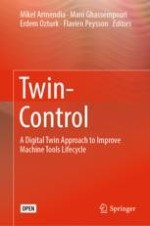11.1 Introduction
11.2 Machining Module
11.3 Coupling Architecture
11.4 Simulation of Machining Sequences
11.4.1 Simple Machining Process with the High-Speed Box-in-Box Machine
-
Move z-axis forward to have a cutting depth of 4 mm.
-
Move y-axis up to simulate one cutting pass (milling with an end-milling cutter) as shown in the zoom of Fig. 11.6. The nominal tool y-velocity is 1.9 m/min.
-
Tool spinning velocity is 12,250 rpm.
-
Technological parameters correspond to two cutters end-milling tool that machines an aluminium holed workpiece.
11.4.2 Machining Process with Tool Change on a Multi-spindle Machine
-
Spindle 1 (right) is equipped by an end-milling tool (Diameter 10 mm–three cutters–corner radius 2 mm).
-
Spindle 2 (centre) is equipped by an end-milling tool (Diameter 12 mm–two cutters–corner radius 6 mm).
-
Z-axis is moved down to have a 4 mm cutting depth.
-
X-axis is moved forward to simulate a first cutting pass. The nominal tool x-velocity is 3 m min−1.
-
Set spindle speed to 12,250 rpm.
-
Once first pass is done, tools get out of the workpiece, and the machine gets back to its initial configuration. Tools are exchanged between both spindles, machine is shifted in the Y-direction and the operation is repeated.
